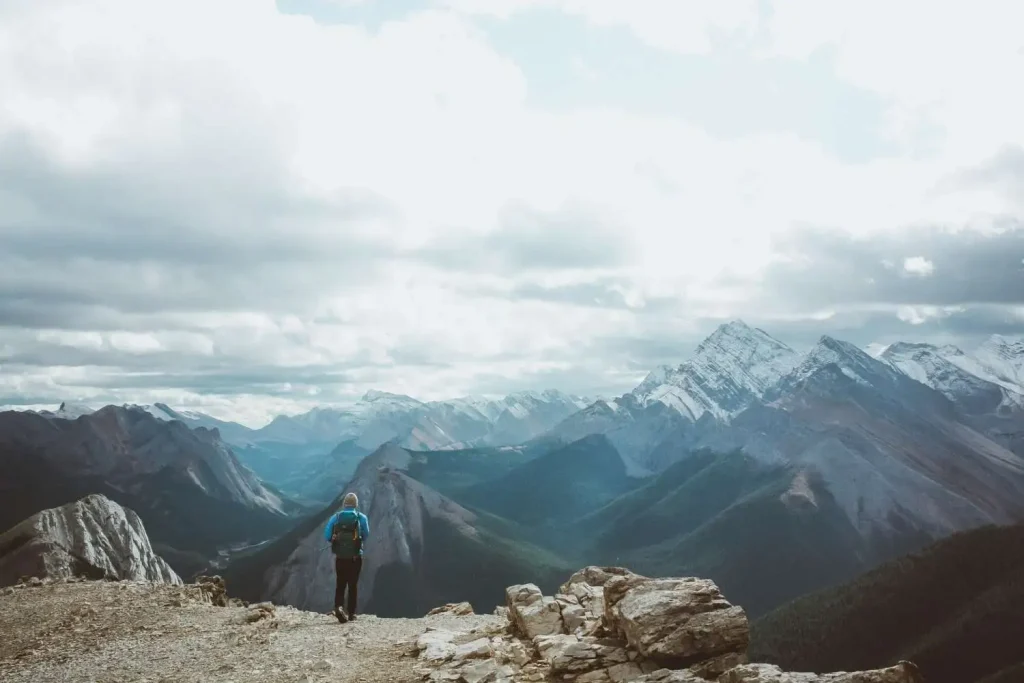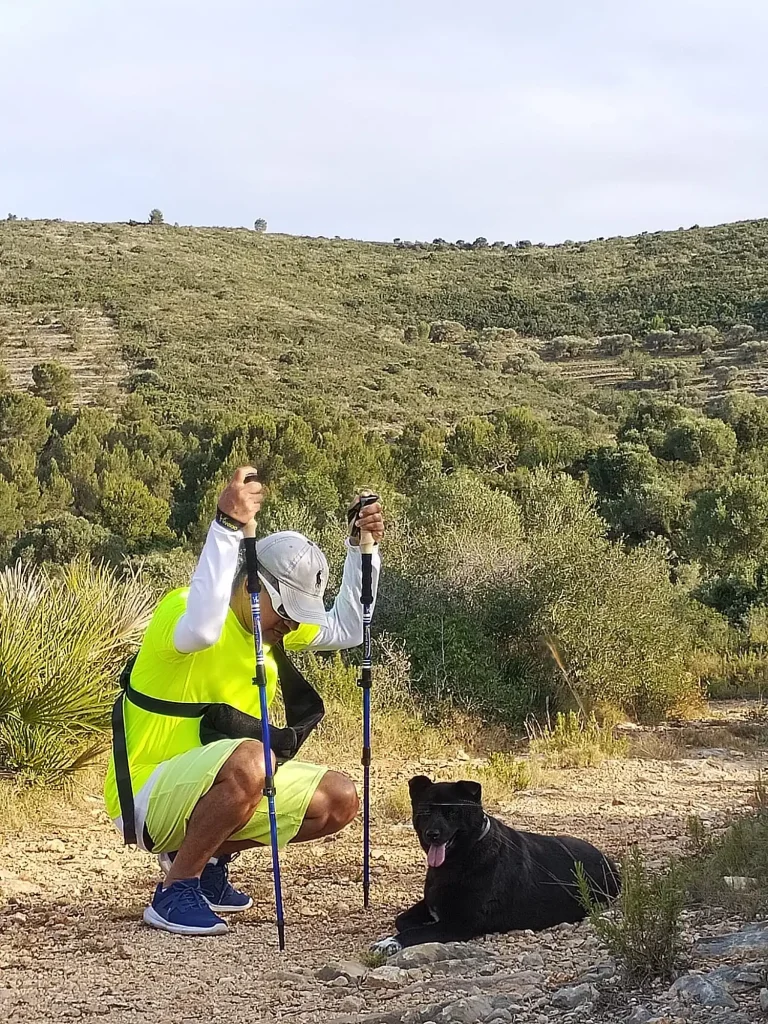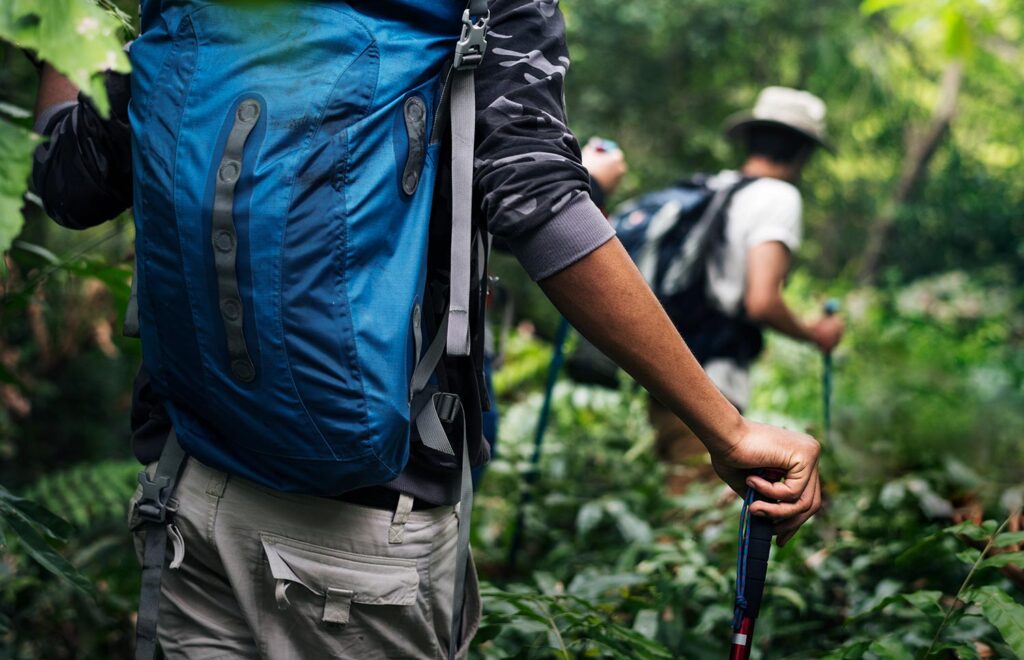Everything you need to know about this sport to enjoy it.
HIKING
It consists of non-competitive routes on foot along marked and/or approved trails. One of its goals is the knowledge of the natural environment and cultural heritage of the area in which it is practised, and therefore it can be said that it is a symbiosis between sport, culture and environment. It has been proven that hiking brings multiple benefits to people. In English it is called Hiking.
GENERAL CHARACTERISTICS OF HIKING ROUTES:
- Marked and/or approved trails in medium/low mountain areas.
- Difficulty: Easy / Medium
- Duration: routes that can be completed in one day (usually).
- Equipment: as foreseen / needed during the day
- Used backpack: 20-30 litres capacity
ESSENTIAL EQUIPMENT FOR HIKING:
- Footwear
- Warm clothing
- Socks
- First Aid Kit
- Backpack
- Torch / headlamp
- Sun protection
- Hydration and nutrition
- Smartphone
- Identification
RECOMMENDED MATERIAL:
- Technical clothing
- Walking sticks
- Maps and compass
- GPS device
- Multi-purpose knife
- External battery
- Camera
- First aid kit
TREKKING
Trekking, unlike hiking, involves routes that require several days to complete, with a higher level of difficulty, as they are usually carried out in high mountain terrain, or in remote and difficult to access places. The paths used may or may not be signposted. It also implies a higher level of self-sufficiency, which requires the use of a backpack of greater capacity, as well as more technical equipment that allows adaptation to inclement weather. Overnight stays between stages can be in mountain refuges or in tents or bivouacs.
The origin of the term trek goes back to the 1980s: treks were (and are) the long approach walks to the base of mountains, carried out by mountaineers who wish to climb them, in areas such as the Himalayas or the Andes.
GENERAL CHARACTERISTICS OF TREKKING ROUTES:
- All types of trails, usually in high mountain areas. Also routes without trails or marked trails
- Difficulty: Medium / High
- Duration: routes that require several days to complete.
- Material: more technical and adaptable to weather conditions
- Used backpack: 40-60 litres capacity
Here are some tips to help you decide what to pack for a multi-day hike.
1. THE BACKPACK
The equipment you take with you will be determined by the length of the backpacking trip, the capacity of the backpack and the weight you can comfortably carry. We are going to focus on a trekking trip of several days and assume that we use a 60 litre backpack. Additional accessories that you can consider to complement your backpack:
- Watertight inner bag: If rain is a serious possibility on your hike, consider carrying one (or more) of these in your backpack. They'll keep your clothes dry, but also help you keep your gear more organised, store dirty or wet clothes, etc. They are very light so they don't add extra weight.
- Drysacks: similar to the above, but with a higher level of protection against water.
- Ultra-lightweight, foldable backpack: Sometimes you may leave your main backpack at a mountain hut or hostel and go on a short hike or visit a village. In these cases, an ultra-lightweight folding backpack will come in handy, for carrying money, extra warm clothes, smartphone and other frequently used items.
- Large capacity hydration system (3 litres): for trekking in remote areas or self-sufficiency you will probably need to carry a significant amount of water, at least 3 litres. Remember that constant and adequate hydration is an essential part of enjoying a multi-day trek.
2. TREKKING CLOTHES
It is important to take the right clothing for the climate in which you are going to move, and to be clear about the characteristics of the season in that place. For example, if you are travelling to an area where there is a rainy season, you will need to keep this in mind when putting together your gear. Similarly, if you are travelling to a hot area with extreme temperatures, your gear will need to be suitable for those rigours. Leave nothing to chance. Here are some recommendations:
- Mountain footwear: boots or trekking shoes. Make your choice based on the expected temperatures and weather conditions. Remember to always bring a pair of shoes to rest in after your hikes, and flip-flops if you have to shower in public areas.
- Trekking socks: along with footwear, one of the most important parts of the equipment. It is very important that they are breathable, comfortable and do not cause blisters.
- Gaiters: as well as being essential on winter walks, they can also be very useful in muddy or very wet areas: they will help keep your boots and socks dry.
- Base layer (layering system): it is always important that the base layer of our clothing is breathable, whether we are going to move in warm or cold temperatures. If your base layer is not able to wick away moisture from your perspiration you may experience problems such as cold or chafing.
- Middle layer: the middle layer will be in charge of providing the warmth your body needs, as well as continuing the ventilation function that the base layer started. Again, choose according to the expected weather.
- Outer layer: this third layer will protect you from wind and rain. We are usually talking about breathable and waterproof membranes, very versatile garments due to their protection and lightness.
- Trousers: a good option is a pair of detachable trousers (usually with zips), which will be useful in a variety of situations. Don't forget a pair of waterproof over-trousers to wear over the trousers if the risk of rain is high.
- Poncho: a good option for protection from rain, but only in cases where you will be moving over easy terrain.
3. BASE MATERIAL
Your base material will be what gives you the confidence to survive the day to day trekking or backpacking trip, whether it's for pleasure or hardship.
- Map: No matter how familiar you are with the terrain, or how reliable you find technological orienteering aids. Always carry a map with you on a multi-day trek.
- Compass: it usually takes up very little space and is very light, so taking the risk of not carrying it is probably not going to pay off. You never know when you might need it.
- First aid kit: you can buy ready-made kits, or make your own. Remember to include some blister protectors and water purification tablets, among other items.
- Survival lighter: it is very comforting to light a campfire at the end of the day, but pay attention to the regulations, as in many places it is forbidden to light a fire.
- Toiletries: toothbrush, deodorant (have you tried alum stone?), Vaseline for chafing, soap, sun cream, etc.
- Torch / headlamp: one of the essential pieces of equipment that should not be missing in your basic equipment. Nowadays there are battery-operated or rechargeable battery-operated flashlights.
- Sleeping bag: choose according to the temperature range you will be moving in.
- Insulation mat: an essential component, along with the sleeping bag. Consider choosing an inflatable mat for extra comfort.
- Tent: if you have to carry a tent, make sure it is a lightweight model, but still provides the necessary security.
- Multi-purpose knife: without a doubt, a must-have. You never know when it's going to get you out of a jam.
- Other items: lanyard, adhesive tape, GPS, external battery for smartphones, sunglasses, insect repellent...
4. TRAVEL ESSENTIALS
These are some essentials that really live up to their name. Make sure you have them ready before you start your trek or trip.
- Travel Insurance: to protect your equipment, your wallet, and most importantly, you.
- Vaccinations: find out if they are required where you are travelling to.
- Up-to-date passport: in addition, we recommend that you carry it photocopied and stored separately, and/or scanned into your smartphone.
- A friend or family member: no, you don't need to carry it in your backpack, but it's always advisable to tell someone about your plans so they know where to find you in case of emergency, especially if you're trekking or travelling alone.
MOUNTAINING
In general terms, it could be said that mountaineering is the sport of climbing and descending mountains. Mountaineering is carried out in high mountain areas, which in Spain are those located above 2,000-2,500 metres above sea level. In high mountain areas the climatic and environmental conditions are extreme, and therefore there is a high risk to people's health. Mountaineering is not simply a sporting activity, but has a strong exploratory component, inherited from the innate human spirit of discovering new territories. Mountaineering originated in the Alps at the end of the 18th century, hence one of its synonyms is alpinism.
Mountaineering includes a multitude of specific activities, such as canyoning, ice climbing, ski mountaineering... For this reason there is a wide variety of materials to be used. The duration of the activity can also be very different depending on the speciality.
General characteristics of mountaineering activities:
- High mountain areas
- Difficulty: High or Very High
- Duration: one or several days
- Equipment: very technical and suitable for winter conditions
- Backpack used: 30-100 litres capacity, depending on the activity.



